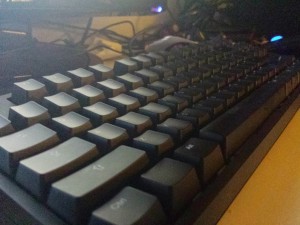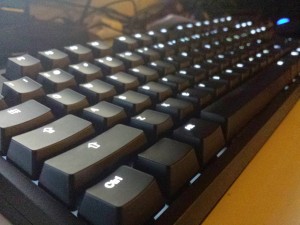Let me preface this post by saying that I am by no means a typer. I have never really took time to look into what keyboards were good, what keyboards I liked the best, or what keyboards allowed me to type the best. To further prove my point, all of my previous typing was done on the Microsoft Sidewinder X4, a keyboard that I am almost positive lacks merit in the land of keyboards that are “typing” boards.
The world of mechanical keyboards has interested me for quite some time now. Their clicky nature, their claims for faster speeds, the way that they feel while typing. Everyone always had good things to say about mechanical keyboards, and I’ve never had one. Thus, it only made sense that I got one. Following the recommendations of a few friends and of Jeff Atwood himself, I decided that I would go ahead and get the CODE keyboard without a number pad and with Cherry MX clear switches. What this meant, I had no clue. I was more than excited to get started.
I have been using this keyboard for about a day. So far, I love it. Typing feels great, the sound is very satisfying, and the amount of tactile feedback really is incredible. There is no question as to whether or not I hit a key or I just kinda-pressed it. The keys actually depress as you press them, and I think that’s awesome.
Build Quality
As far as the keyboard itself goes, it feels great. It’s a little on the heavy side, but I don’t think that anyone ever expects a keyboard to be comparable to a feather. After all, all it really does is sit on the desk. The material feels solid, the keys look beautiful, and the paint gives the keyboard a classic look when the LEDs are toggled off, but a beautiful modern look when the LEDs are toggled on. In fact, when I first opened the box for the keyboard, I was a little underwhelmed. Without knowing what it was, it looked just like a normal keyboard. However, as soon as I held it, flipped a couple optional switches, ran the USB wire in its dedicated slot, and began typing, I knew this was no ordinary keyboard. It felt great. It still does.
The Sound
One thing that always interested me about mechanical keyboards was their sound. They sound as if you’re actually typing. Because of that, I was very concerned when picking out a keyboard. Now, I know nothing about the different color switches and which ones are loud and silent and soft, but I wanted to make sure that the keyboard I got had a satisfying sound, while not keeping my roommates awake. This keyboard (with the help of the MX Clear switches) does exactly that. It definitely isn’t too loud, and actually doesn’t require the keys to “click” in order for them to be pressed. The most noise is produced when the keys are fully depressed. However, while typing one will quickly realize that isn’t necessary. A keypress is registered about halfway down. Thus, there is no need to actually “click” the key. Not only does this provide a non-irritating sound profile, but it also gives the typer a little bit of control as to whether or not they want to be a quiet typist or the most annoying computer user in the library (of course, this means that you would have to bring the keyboard with you to the library).
The Feel
So many people raved about this keyboard because they felt “pleasured” to type on it. It was relaxing and it felt great. Honestly, as someone who is not a typing enthusiast, I don’t feel much “pleasure”. So far, I find that it is actually fairly tiring typing on this device. Now, keep in mind that I come from the world of chiclet laptop keyboards, so I definitely do not appreciate the levels of effort required to type on such a well-built device; however, all of the wild claims about this being the “best feeling” keyboard ever made do not resonate with me. As of right now, at least, I do not feel anything special.
Of course, I am not trying to say that the device doesn’t feel good. It feels good. I enjoy typing on it because of its sleek design, it’s clicky-clack nature, and it’s beautiful LEDs. However, I do not think that I would find myself carrying this keyboard around because using anything else would be an abomination and a sign of disrespect to my fingers. If anything, my fingers will need a bit of a break after typing on this device for so long. However, for a typing enthusiast, I can definitely see how this device has potential to feel great. I just don’t notice anything super outstanding.
Overall, I am very pleased with my purchase. Keep in mind that I have only been using it for a day, so I can’t comment on much, but I am not suffering from any buyer’s remorse, which is always a good sign. If anything, this keyboard is making me want to type more and learn how to actually type properly (I currently type in a strange fashion where 75% of the keys are typed using my index fingers. I will work on changing this soon!) There will be more comments to come regarding the CODE keyboard!


